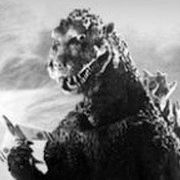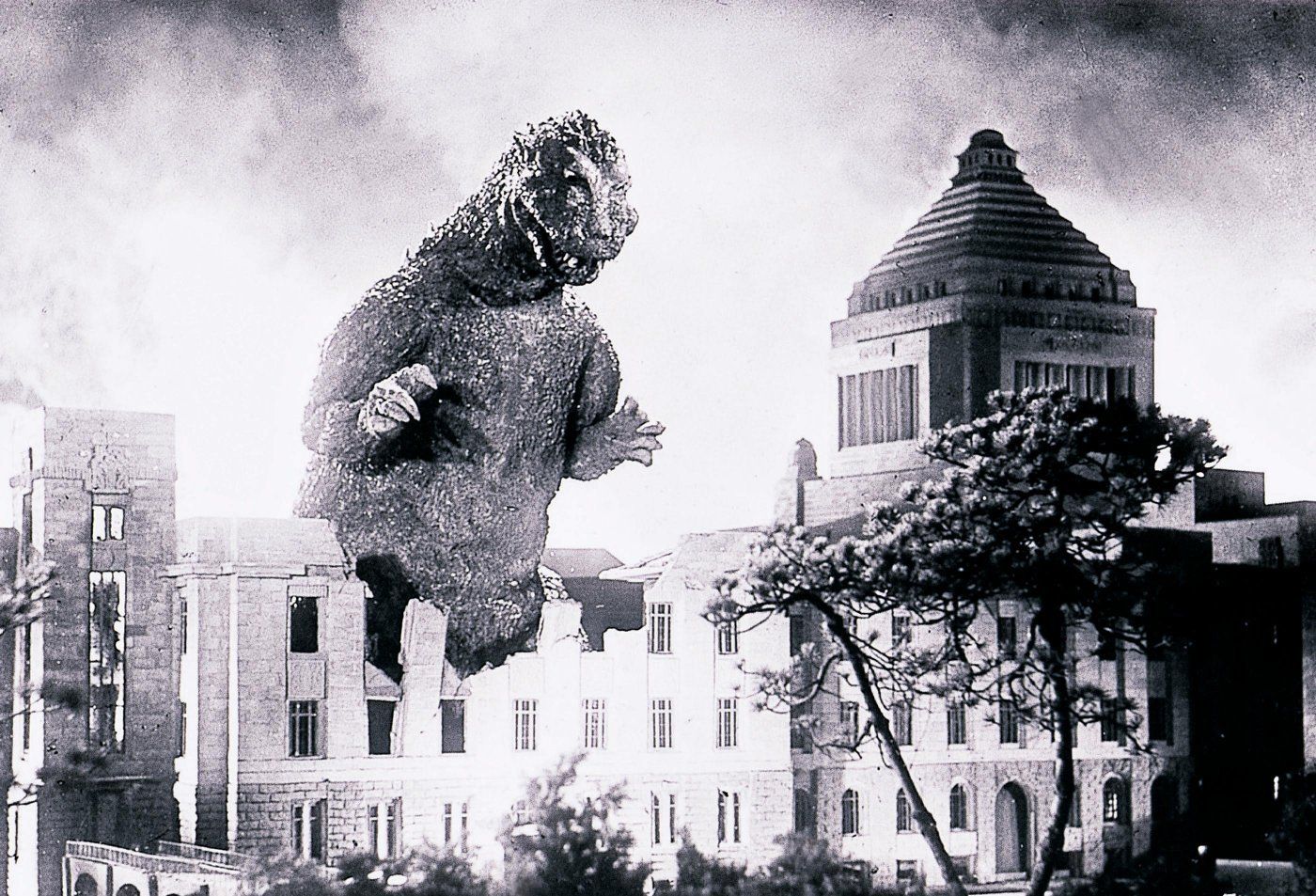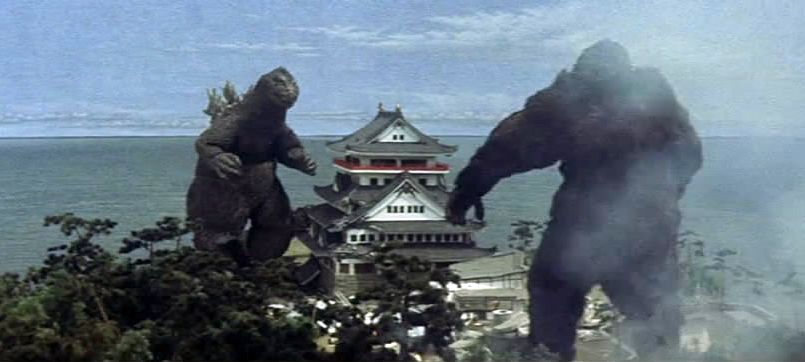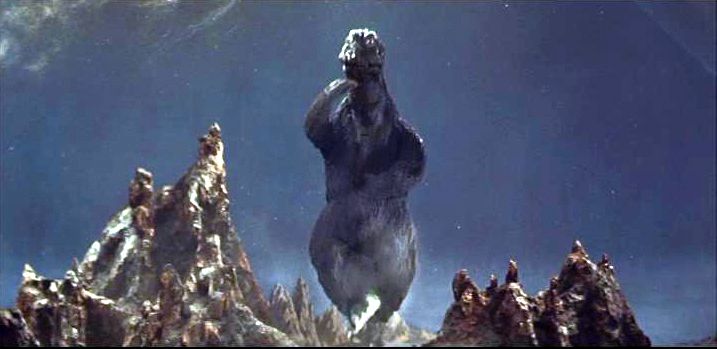Somber, earnest and bereft of the wrestling moves that helped him vanquish his towering adversaries, Gareth Edwards’ Godzilla reboot introduces a prehistoric beast that looks and behaves unlike any iteration of the King of the Monsters audiences have seen in decades. The film not only pays tribute to the franchise’s origins, but marks a return to the earliest days of the creature itself, a terrifying postwar metaphor disguised as popular entertainment.
After decades of associations with campy showdowns between rubber-suited stuntmen as they trash miniature cities, it remains to be seen whether movie-goers will respond eagerly to Edwards’ more serious, sincere chronicle of the character’s destruction. But with the new film arriving in theaters during the 60th anniversary of Godzilla’s introduction, its opening serves as an overdue reminder of the journey the character has taken to achieve iconic status.
When Godzilla (a phonetic translation of its Japanese name Gojira, portmanteau of the words for “gorilla” and “whale”) was initially released in Japan, it arrived approximately a decade after the end of World War II, offering a sobering reminder of the devastation its people had gone through. From its opening scenes depicting the destruction of a fishing boat, which recalled a real-life maritime incident in which the Lucky Dragon 5 was overwhelmed by the United States’ Castle Bravo nuclear test in the Marshall Islands, the film borrowed liberally from the country’s recent history to create an atmosphere of inescapable loss. Watching the film now, in its beautifully restored original incarnation, the sense of cultural mourning is palpable: After one attack by the yet-unseen monster, parents plead with officials for news about the identities of his victims. After Godzilla lays waste to Tokyo, a mother tearfully clutches her children, taking feeble solace in the prospect of a reunion with their late father while waiting for the debris to rain down on the three of them.
Although we think of the series’ use of rubber suits and miniatures as cheap and campy, director Ishiro Honda was working on an epic scale using the best resources the Japanese film industry had to offer. According to Steve Ryfle, a Godzilla expert who wrote the book Japan's Favorite Mon-Star: The Unauthorized Biography of "The Big G," the reason a “serious” Godzilla seems like anathema is not because of the filmmakers’ execution but because of the way the movies were subsequently sold to international audiences, particularly in the United States. “One of the things that is misperceived is that they were B-movies,” he explained. “But they were anything but: the original series of Godzilla films were made at the peak of the Japanese film industry, which for a brief time was the most prolific national film industry in the world.”
“If you look at these films, they have some of the same actors and crew members as films made by some of the more respected Japanese film directors at the time,” he continued. “The fact that they’re seen as B-movies is largely due to the way they were marketed here. They were bought by distributors of B-movies, and were packaged just like they packaged all of their other B-movies.”
“So I think that perception has to do with the time period when they were imported, and the way that they were marketed, and again, the fact that they were Japanese – that kind of stigmatized them too.”
Ironically, while the monster’s seemingly unstoppable force embodied Japan’s nuclear holocaust, the film itself became synonymous with the most popular mainstream entertainment of the time, precisely because it tapped so deeply into the audiences’ fears, in such an engaging and thoughtful way. Meanwhile, American producers re-edited the film, adding in footage of an English-speaking reporter played by Raymond Burr, and effectively neutered its sociocultural underpinnings for viewers outside its native country, not to mention reduced its appeal to the camp of clumsy monsters and unconvincing models.
It wasn’t until the 1990s that American audiences first got to look at the film in its original version, but the success of that heavily reworked cut made Godzilla an international icon in the intervening decades, if not necessarily in the way in which the filmmakers churning out sequels intended. Ryfle said that his introduction to the character was through television reruns of the sequels, whose exoticism provoked more thought and inspired more imagination in the budding fan than any of the American films with which they shared programming time. “I spent a lot of my childhood watching creature feature-type programs on television on Saturday afternoons,” he explained. “There were stations that were constantly running and rerunning science fiction, Western, action B-movies, and the Toho stuff was a big part of that.”
“I was able to accept their alternate reality a bit more than I could the American science fiction films – because they were Japanese,” he observed. “Not only the make-believe world, but the world they were set in, the city, the people, the behavior, it was different, and that difference helped me accept that world. And then I remember thinking, who are all of these people who made the films?”
Ryfle’s burgeoning interest in the series mirrors that of many other fans who similarly absorbed Godzilla’s scuffles with various foes, which were characterized by their decidedly anthropomorphized interpretations of the character. By 1962, for example, the public’s appetite for broader performances in the suit preempted the filmmakers’ intent on keeping Godzilla purely destructive. “King Kong vs. Godzilla was pivotal, not because it was so successful in Japan, but because it was the first of the monster-versus-monster wrestling match movies,” Ryfle explains. “Because it was so successful and Godzilla started to clown around a little bit in that film, and King Kong as well, that sort of determined the direction of the franchise from that point forward, even though Ishiro Honda, the director, really had misgivings about that.”
As one of the most successful installments in the franchise’s history, King Kong vs. Godzilla served as a turning point for the studios’ approach to the character going forward. “The studio was really pushing that because it was a formula that worked in that film in particular for adults and their children. So you began to see in subsequent films that they were doing things like, say, dancing a jig after he defeated King Ghidorah in 1965’s Invasion of Astro-Monster.”
As easy as it might be to blame market forces on the evolution, or perhaps “transformation,” of Godzilla’s personality, Ryfle insists the changing times in Japan, including some much-needed distance from the nuclear destruction of World War II, also sparked some of those shifts. “A lot of it has to do with the changes that were going on in Japan during the 1960s. I mean, the country basically left WWII, all of those things, behind, and then the Olympics of 1964 came and the country underwent a massive economic boom with all of the construction and things like that. Everybody’s lifestyles began to improve, incomes went up and it was a very prosperous time.”
“The atmosphere that Godzilla was made in was 10 years after the war and this personal malaise still hanging over Japan, that was over and done with,” he observed. “And I don’t think a somber nuclear metaphor, a constant reminder of the horror and destruction that the war brought, was big at the box office at that time. It kind of evolved to stay relevant with the times, and so by the end of the ‘60s, Godzilla was a parent who had a child, and in the film he wasn’t acting like a parent, he was basically acting like a superhero.”
Despite the changing times and the friendlier, funnier face of Godzilla, however, the series lost little of its social commentary, no matter how outlandish its monster-versus-monster scenarios became. For example, although Mothra originated in a fantasy novel, on film the creature’s story offered a thinly veiled critique of America’s postwar relationship with Japan. “Mothra is another [turning point] in that the approach was quite different,” Ryfle said. “It’s a wonderful, dreamy kind of film, but it also has almost this sort of political subtext. … The plot of the film revolves around exploitation of Mothra’s fairies by a woman from a fictional nation whose name is a hybrid of Russia and America, called Rolisica.”
“At that time, Japan was inextricably tied to Washington,” he explained. “Japan was kind of caught in this political rock and a hard place, because the security arrangement with America was terribly one-sided. The agreement was basically designed to allow the United States to keep military bases there, but it didn’t obligate the United States to defend Japan militarily.” Ryfle indicated that the final film toned down its nods to these political conflicts. “Actually, the original story was changed before it went into production but there were even more direct references to the [treaty],” he said.
“So the creation of this villainous character who is exploiting Japan is very cartoony, but people don’t realize if you were Japanese sitting in the audience in 1961, I think you would kind of get the idea that this was relative to what’s going on, in a sort of metaphorical, allegorical way.”
Given the tone and content of the films in the Godzilla series, it seems almost comical to imagine deeper meanings in their fantastical conflicts. But Ryfle acknowledges the majority of audiences now would have little clue about the political tenor of the times in which these movies were released, perhaps unfortunately diminishing their individual (and cumulative) achievements. “I don’t think there are many Americans watching them today who are familiar with Japanese postwar history,” he said. “You wouldn’t get those references, and they’re the kind of thing that is prevalent in all of the films.”
“Even if the films aren’t terribly political, if they’re entertainment vehicles, they often have some sort of subtle or sly comment on whatever’s going on at the time.”
That said, even an expert on the franchise and an enthusiast of all of Godzilla’s iterations won’t argue that there are a few installments in the series that are a little too silly to take seriously, even if their message might be deeply necessary. “Godzilla vs. The Smog Monster [also known as Godzilla vs. Hedorah] is one of the campier, weirder films in the series,” he confessed. “It’s definitely the weirdest. It’s got hippies and psychedelia, people going to a club where they’re flashing amoeba blobs on the wall while people are dancing with body paint and all of that stuff. And the monster, the villain monster, is basically a big pile of sludge. It came out around the same time as the first Earth Day, and it’s basically a pollution monster. It feeds on smokestacks of coal plants, but it looks like it’s taking bong hits – it’s hilarious.”
“That movie was so weird that the guy who directed it, he never directed – well, he directed another film but not a monster film,” Ryfle revealed. “At the time, they claimed that the guy ruined the franchise.”
After Edwards’ film lumbers into theaters, audiences will vote with their wallets on whether his authentic, serious interpretation of Godzilla still resonates, or if suplexes and balsa-wood buildings will continue to define the creature’s cinematic landscape. But Ryfle said his sense of what’s being true to the character is, perhaps appropriately, a little more primordial than political. “Godzilla has to fight other monsters,” he said simply. “That’s kind of the classic setup. And in fighting that other monster, Godzilla has to take some punishment – he basically has to get down on the mat – and get back up again before he wins.”
“That’s kind of the classic scenario in these films,” he continued. “People want to root for Godzilla, but they also kind of expect him to take a bit of punishment, comeback, find his second wind, channel something within himself, and beat the pants off other monster.” He also suggested that their ongoing affection for the film series and character in general has complicated psychological underpinnings, tied to the creature’s origins, even if they don’t consciously realize it.
“People want their Godzilla invincible and a force to be reckoned with, a force of nature, but at the same time they want to root for him,” he said. “I mean, everybody wants to cheer for Godzilla, but I think they want to be a little bit afraid of him too.”
Ultimately, with 60 years and 30 films to draw upon, there is no longer a single point of entry into the Godzilla franchise, nor is there a singular interpretation of the monster. “Everybody has their own Godzilla,” Ryfle said. “Everybody comes to Godzilla with their own path. Some people do from watching the campy films like King Kong vs. Godzilla, which are basically monster wrestling matches. Younger kids grew up watching the later films, when Toho kind of relaunched the franchise in the ‘90s or even after that, and were made by people in Japan who grew up watching the original film, and were done as a tribute to the original movie and are done a little more seriously. [And] the filmmakers on the Legendary one are trying very much to pay tribute to the original film by taking their film so seriously, and trying to make it relevant to things that are going on in the world today.
“So it’s almost like the franchise is basically circling back to a place that’s similar to where it started.”
Early ads for Edwards’ film offer only glimpses of the monster, a literal and metaphorical force of nature that dwarfs mankind’s achievements and renders laughable the illusion we are capable of dominating our environment. (That they use Gyorgy Ligeti’s “Lux Aeterna,” so memorably employed by Stanley Kubrick as the “voice” of his transformative monolith in 2001, only seems to reinforce Edwards’ reverence for the character’s awesome power.) Projected on a world stage, transcending the geographic and cultural boundaries of the character’s origins, Godzilla’s continued existence offers a sobering reminder for all audiences that there are some things in our world that are bigger than our understanding, and especially bigger than our control. And somewhere between the majesty of that discovery and the terror of its unpredictability lies the creature’s appeal: Everybody wants to cheer for Godzilla, but they want to be a little afraid of him too.





